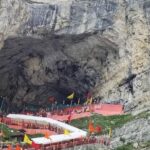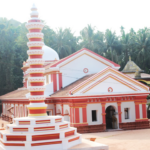The Omkareshwar Jyotirlinga is one of the twelve Jyotirlingas of Lord Shiva and is located on the Mandhata Island in the Narmada River, in Madhya Pradesh. The island itself is unique as it is shaped like the sacred Hindu symbol “Om”, which makes it a particularly revered pilgrimage site.
Mythological Significance:
The Omkareshwar Jyotirlinga is associated with various legends:
- Story of Vindhya’s Penance: According to one legend, the Vindhya Mountain (personified as a deity) once performed intense penance to please Lord Shiva, seeking power. Pleased by the devotion, Lord Shiva appeared before Vindhya and granted his wishes. Shiva manifested as the Omkareshwar Jyotirlinga on the island of Mandhata in the Narmada River. The shape of the island is said to resemble the sacred syllable “Om”, representing the primal sound of creation in Hinduism.
- Shiva’s Duel with the Demons: Another legend tells of how Lord Shiva appeared in the form of Omkareshwar to destroy the demons who were oppressing the gods and sages. He saved the gods from the demon king and his army, establishing his presence on Mandhata Island as Omkareshwar.
- Dual Forms of Omkareshwar and Mamleshwar: It is said that there are two distinct forms of Lord Shiva at Omkareshwar: Omkareshwar (on the island) and Mamleshwar (on the southern bank of the Narmada River). Both are worshipped as part of the Jyotirlinga, making this one of the only Jyotirlingas with two shrines dedicated to Shiva.
Historical and Spiritual Importance:
- The name Omkareshwar comes from “Om,” the cosmic sound or syllable that represents the universe’s creation and the supreme consciousness. Worshipping Lord Shiva here is believed to lead to both material prosperity and spiritual salvation.
- Adi Shankaracharya, the great philosopher and theologian, is said to have visited Omkareshwar and debated with Mandan Mishra, a famous scholar, marking a significant moment in Indian spiritual history. This debate is often cited as a turning point in the consolidation of Hindu philosophical thought.
Architecture and Layout:
- The Omkareshwar Temple is built in the Nagara style of architecture, which is characterized by its towering shikharas (spires) and intricate carvings. The temple is located on Mandhata Island and is accessible via a boat ride across the Narmada River or by a bridge connecting the mainland and the island.
- Main Sanctum: The sanctum sanctorum of the temple houses the Omkareshwar Jyotirlinga, which is worshipped by thousands of devotees daily. The sacred atmosphere of the temple, combined with the island’s natural beauty, provides a deeply spiritual experience.
- Mamleshwar Temple: Located on the southern bank of the river, the Mamleshwar Temple is often considered equally important and is part of the pilgrimage. It is believed that both Omkareshwar and Mamleshwar together complete the Jyotirlinga’s divine energy.
Festivals and Worship:
- The most significant festival celebrated at Omkareshwar is Maha Shivaratri, when thousands of pilgrims come to offer prayers to Lord Shiva. Special rituals and a grand procession are held during this time.
- The Shravan month (July–August) is also highly important for Shiva worship. Every Monday during Shravan, special prayers and processions take place, drawing many devotees to the temple.
- Narmada Parikrama: Devotees often undertake the Narmada Parikrama, a circumambulation of the Narmada River, which is considered highly auspicious. During this pilgrimage, the Omkareshwar Temple is an important stop, as the Narmada River is believed to be one of the holiest rivers in India.
Spiritual Beliefs:
- Worshipping Lord Shiva at Omkareshwar is said to bring immense blessings, including relief from past sins and liberation from the cycle of birth and death (moksha).
- The Omkareshwar Jyotirlinga is unique due to its connection with the sacred syllable “Om,” which represents the ultimate truth and the essence of all existence. Devotees believe that by worshipping Lord Shiva here, they can attain both spiritual wisdom and worldly success.
- The Narmada River, which flows around the temple, is itself considered sacred, and pilgrims take holy dips in the river before visiting the temple.
Architectural and Natural Beauty:
- The Mandhata Island, shaped like the symbol Om, is a natural wonder in itself. The scenic beauty of the river, the hills, and the temple creates a serene environment that attracts both spiritual seekers and nature lovers.
- The architecture of the Omkareshwar Temple is a blend of ancient and medieval styles, with beautiful carvings that depict various deities and mythological scenes. The temple has been renovated and maintained over centuries, yet it retains its ancient charm.
How to Reach:
- Omkareshwar is well connected by road and is about 80 km from Indore, the nearest major city. The nearest railway station is Omkareshwar Road, and the nearest airport is in Indore.
- The temple is accessible via a boat ride or a walk across the bridge over the Narmada River. Both modes of access provide a scenic journey, offering beautiful views of the river and the surrounding hills.
Conclusion:
The Omkareshwar Jyotirlinga is one of the most sacred sites for Shiva devotees, revered for its unique association with the “Om” symbol and its location on the banks of the holy Narmada River. Its rich mythological background, spiritual significance, and natural beauty make it a must-visit for those seeking divine blessings and a serene pilgrimage experience. Visiting Omkareshwar is believed to bring peace, prosperity, and liberation from the cycles of birth and death.













